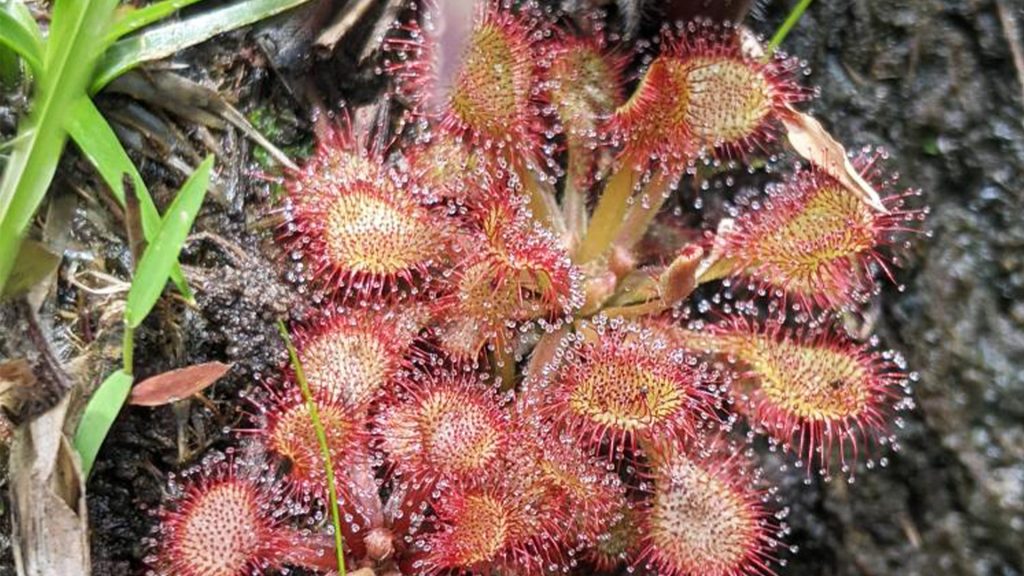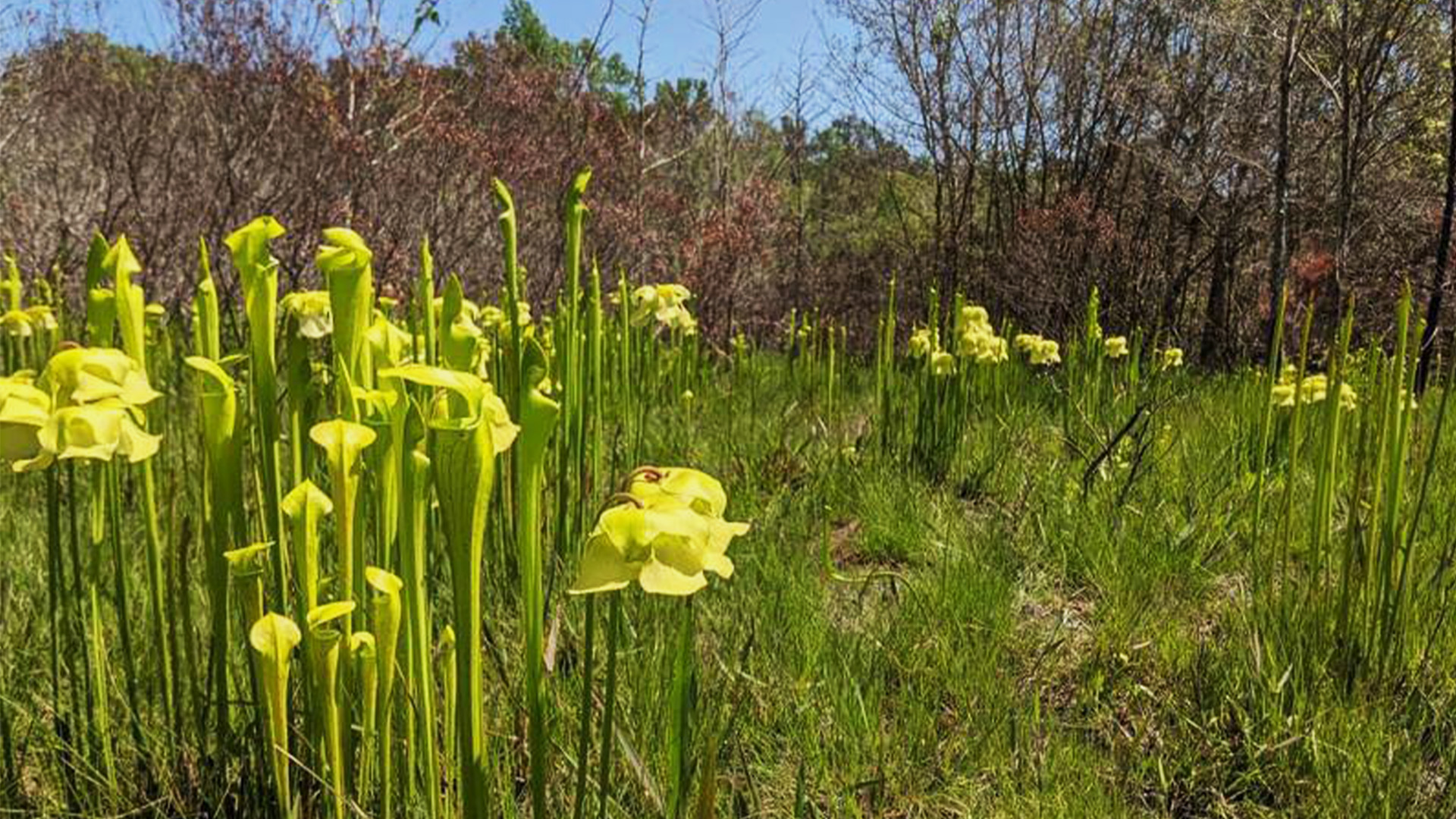Helping locals “meat” their native carnivorous plants
When you hear the word “conservation,” what comes to mind? Is it large swaths of protected rainforest? Hiking through a national park? The breeding programs at the zoo? Teams of hard working vets rehabilitating and releasing injured wildlife? Or could it be the wetland around the very bend from your house? Or even your backyard or balcony filled with native flowering plants?
For many of us, the concept of conservation ends up being something grand, and usually far away, where conserving and protecting nature in our own neighborhoods gets a bit overlooked. Despite this, small scale and local conservation is just as important for creating a healthier and happier planet. Not only do we help out our local plants and animals when we create healthy natural areas close to home, but natural areas do a lot for people, from filtering water, to trapping carbon, and even helping boost our mental health. In short, if we practice conservation in our own backyard, everyone wins.
So, how do we get people to fall in love with what is right in front of them? Well, it starts with knowing what is, and what could be, there in the first place. When people have a better idea of what plants and animals are native to their area, they might feel a stronger sense of belonging and stewardship, and care more about protecting it. Because if you think about it, why should you care about something that you don’t even know about?
Curing “Plant Blindness”
For conservation in general, plants tend to get overlooked – there is even a term for it called “plant blindness” – but learning to appreciate native plants and encouraging their growth is key to making this all work. Fostering a love and appreciation for native plants is especially important for conservation because plants make the base of our ecosystem, and having abundant healthy native plants is crucial to creating habitat that can foster more wildlife, such as charismatic butterflies and bumblebees, and so on. Besides, the more you learn about plants, the more surprised you become by how incredible they can be! One group of plants that stands out as really interesting, quite important, and in need of conservation, are carnivorous plants.
Carnivorous plants are an incredible product of evolution where the leaves are specially adapted to be able to do something most plants can’t – eat meat! These plants have evolved this ability because they usually live in areas with low soil nutrients, and consuming insects, or other organic material, is their way of compensating for that. These plants come in many forms, the most well known being the venus fly traps that snap shut when an unsuspecting insect lands on them.
There are also others, such as pitcher plants – which have leaves that form large pitchers filled with a liquid or sticky substance, trapping and consuming what falls inside. Really, there is a huge variety of carnivorous plants worldwide with different shapes, sizes, and strategies, but generally the insect prey is lured into the traps by a combination of sweet nectar and a variety of different scents – depending on their prey of choice, and sometimes even changing with the season!
In North America, there are a lot more species of carnivorous plants than you might think! Here, these plants are found primarily in wetlands. Unfortunately for them, wetlands are a highly threatened ecosystem, which is not great news for their conservation. However, there is hope for them, since there are people who are working hard to bring wetlands and their unique plants the attention, appreciation, and conservation efforts that they deserve.

Saving Native Carnivorous Plants
With the idea that an effective way to promote conservation is to foster a love for the native plants around you, conservation ecologist Hali’a Eastburn from Carnivero is working with her colleagues to breed resilient plants, educate the public, as well as grow and sell these incredible plants. By doing so, anyone can have carnivorous plants in their home and truly gain an appreciation for them, up close and personal.
With various threats to wetlands and carnivorous plants, Hali’a says that a “big goal of [Carnivero] is to produce plants that are resilient and beautiful.” Through research and selective breeding, the team is working to make these plants more resilient to change, as well as easier to grow in various environments, so people can have them in their yards, gardens, or even in their homes.
For Hali’a, this last part is crucial for the conservation project. The greenhouse works by propagating the plants via tissue cultures so that they are more affordable for everyone. As Hal’ia said “it’s just about accessibility, we want everyone to have access to these plants, [by working with tissue cultures] we can make sure that kids can grow them, that teachers can have them in their classrooms … I think that’s really important because nature is the birthright of everyone, everyone should have access to these plants.”
In addition to helping people own these beautiful plants, bringing them into people’s homes is so important because “for a lot of people these are oddity plants, they’re rare, they look weird… and we’re really trying to demystify the fact that they’re just like regular plants.”
By doing this, the team hopes people will connect more to them and “maybe they’ll seek them out in nature, [and realize that] they’re gone and wonder why, and start asking those questions on their own.” This in turn raises critical awareness for the protection of wetlands. Beyond the greenhouse, Hali’a does educational outreach to teach people about their meat-eating plant neighbors and the importance of wetlands for both people and nature.
Saving the Wetlands
At the end of the day, protecting carnivorous plants is protecting wetlands, and it is an extremely wholesome and clever way to get people to think twice about why they matter. Hali’a said that “we’re already facing this this mass disconnect of people from nature, and you know that term plant blindness comes up often, and people just really don’t know what’s around them at all, so how do you get them to care about some like swampy little pond out there in the middle of nowhere? …but I think that’s what I love about the work I do now.” By teaching people about the plants that they can find around them, Hali’a and her team also foster a curiosity for what else can be found nearby, and ignite a motivation to protect it.
Hali’a also finds that it helps to encourage people to take pride for the plants that are native to their region, by telling them that “these are your plants [that] are native to Texas, and this is yours to own and to reclaim.” She finds this very effective in helping people reconnect with this lost piece of stewardship over the places we live. In this way, that “swampy little pond” suddenly becomes an important part of the land that people take great pride in.

What Can You Do for Wetlands and Carnivorous Plants?
For Hali’a, conservation of native plants is for everyone, in fact, she stated that “your home can be an oasis, it can be a little niche of coziness for your native pollinators and … you can create a really cool little habitat on your balcony – I live in an apartment and I have a balcony full of [native] plants … because I want to create an environment [for the pollinators] and me too, I want access to that environment too so I don’t have to go out to the park or get away from the city to enjoy all those things as well.” In short, even in small places it is possible to create a small habitat for urban wildlife, and for ourselves too, so we can all enjoy greener cities and towns.
If you want to do more for carnivorous plants specifically, Hali’a says to “learn about where Carnivorous plants are in proximity to [you]… find out what’s in your area, find out [if and] why those wetlands are going away.” Advocating for the protection of local wetlands can have a big difference, and is important for our future.
People can also keep their own carnivorous plants. Fortunately “there’s a lot of really great nurseries that are providing these in an ethical manner [that doesn’t involve any poaching].” And if you aren’t sure where to start, she encourages you to “reach out to your local Carnivorous plant nursery. [In our case] our whole staff is trained scientists, …so we can really help you figure out how to grow these plants well.” Having these plants indoors serve as a reminder to protect them, and could help you teach your loved ones about their importance as well.
All in all, conservation can happen on all kinds of levels, and it is important for us to take a step back and think about what we can do closer to home. Although the idea of reconnecting people to nature for conservation often manifests as protecting far away places without people around, the future lies in also loving and protecting what we find right here, in our own backyard.
Learn more about carnivorous plant biology and wetland conservation with Hali’a and Kirstynn on this podcast episode.
Additional posts by Kirstynn Joseph:
How Building a Bee Hotel Can Help Protect Your Local Pollinators










